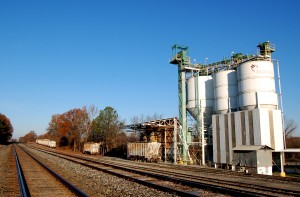Latino Life in Durham
ESPAÑOL
 If you had walked around Durham twenty years ago, you would have found an entirely different story of the Latino community, which was almost nonexistent. According to the Latino Migration Project, only 1% of the total Durham population identified as Hispanic in 1990. El Centro Hispano was birthed just two years later in the basement of El Buen Pastor, an Episcopal church on Liberty Street. Durham then was in the middle of heavy construction, as the final stages of NC-147 (also known as the Durham Freeway) were being completed. The new freeway divided Durham’s neighborhoods and businesses, creating dead zones and invisible boundaries between some of these spaces. In some places, however, business boomed, opening up the job market in both the informal and formal sector.
If you had walked around Durham twenty years ago, you would have found an entirely different story of the Latino community, which was almost nonexistent. According to the Latino Migration Project, only 1% of the total Durham population identified as Hispanic in 1990. El Centro Hispano was birthed just two years later in the basement of El Buen Pastor, an Episcopal church on Liberty Street. Durham then was in the middle of heavy construction, as the final stages of NC-147 (also known as the Durham Freeway) were being completed. The new freeway divided Durham’s neighborhoods and businesses, creating dead zones and invisible boundaries between some of these spaces. In some places, however, business boomed, opening up the job market in both the informal and formal sector.
 In the 1990s, a seasonal agricultural economy had already taken root in North Carolina’s economy, drawing migrant farm workers from Mexico and Central America. By the early 2000s, construction became the new driving force in the Durham economy. After 9/11, security was tightened along the U.S.-Mexico border, altering migration patterns, leading to the increase of the permanent population of Latinos in the U.S. This led to the establishment of Latino-dominated neighborhoods, which proved important to the growing Latino presence in the Durham area.
In the 1990s, a seasonal agricultural economy had already taken root in North Carolina’s economy, drawing migrant farm workers from Mexico and Central America. By the early 2000s, construction became the new driving force in the Durham economy. After 9/11, security was tightened along the U.S.-Mexico border, altering migration patterns, leading to the increase of the permanent population of Latinos in the U.S. This led to the establishment of Latino-dominated neighborhoods, which proved important to the growing Latino presence in the Durham area.
Not long after this population boom, the Latino community realized the importance of mobilizing to protect their own interests after Durham Latinos suffered a wave of targeted robberies and muggings. In 2000, the Latino Community Credit Union (LCCU) was established as a financial center as a solution to this problem, and it has since grown to be an award winning institution. The Latino community in Durham only grew stronger during this time. Spanish-language newspapers flourished, El Centro continued to grow, and Catholic churches saw their pews fill with Spanish-speaking congregations.
By 2010, 14% of Durham’s residents identified as Hispanic/Latino, and 14% as foreign-born. Those numbers are expected to increase. Based on a conservative estimate by the Latino Migration Project, one in three children born in Durham in the year 2020 will be Hispanic or Latino, promising change for the Durham area.
 The booming Latino community has had interesting effects on the Durham community, especially in the education sector.
The booming Latino community has had interesting effects on the Durham community, especially in the education sector.
The Durham Public School system has experienced a painful growth spurt while trying to welcome the increasing numbers of Latino/a students walking into a school system that lacks resources to support sufficient ESL instruction and parent/teacher interpretation services. These interpretation services may prove crucial to Latino student success in schools. According to a 2011 survey from the Pew Hispanic Research Center, 85% of Latinos aged 5 years and older speak a language other than English at home, which supports the importance of teacher/parent communication.
The history of Latinos in Durham is a multi-faceted story that provides us with an important perspective on our diverse community. This website provides different stories from Latinos who have helped Durham grow due to their contributions as entrepreneurs, community leaders, non-profit organizations, artists, and religious groups.
Sources
Arriaga, X.B. & Longoria, Z.N. (2011). Implementation intentions increase parent-teacher communication among Latinos. Basic Applied Social Psychology 33(4), 365-373. doi: 10.1080/01973533.2011.614142
Bridges, V. (2013, October 7). Attracting Hispanic customers easier with solid business legwork. News Observer. Retrieved from http://www.newsobserver.com/2013/10/07/3259779_practicies-for-understanding-the.html?rh=1
Bridges, V. (2012, April 19). Durham Public Schools tackle Latino challenge. News and Observer. Retrieved from http://www.newsobserver.com/2012/04/19/2012218_durham-public-schools-tackle-latino.html?rh=1
Corta, R. (2006). From rural Mexico to North Carolina. In Bridging Spanish language barriers in Southern schools (1.2). Retrieved from http://www.learnnc.org/lp/editions/brdglangbarriers/988
Flippen, C.A. & Parrado, E.A. (2012). Forging Hispanic communities in new destinations: A case study of Durham, NC. City Community, 11(1), 1-30. doi: 10.1111/j.1540-6040.2011.01369.x
I.L. “Buck” Dean Highway. (n.d.). In History Beneath Our Feet: A Guide to Durham Street and School Names. Retrieved from http://museumofdurhamhistory.org/beneathourfeet/streets/ILBuckDeanFreeway
Pew Research: Hispanic Trends Project (2011). Demographic profile of Hispanics in North Carolina, 2011 [Data file]. Retrieved from http://www.pewhispanic.org/states/state/nc/
Sorg, L. (2014, September 10). The Hayti mural and the Durham divide. Indy Week. Retrieved from http://www.indyweek.com/indyweek/the-hayti-mural-and-the-durham-divide/Content?oid=4242301
The Latino Migration Project at UNC-Chapel Hill (2013). Durham’s immigrant community looking to the future. Retrieved from http://isa.unc.edu/files/2013/02/Durhams-Immigrant-Communities.pdf
The U.S.-Mexico: Secure enough (2013, June 22). The Economist. Retrieved from http://www.economist.com/news/united-states/21579828-spending-billions-more-fences-and-drones-will-do-more-harm-good-secure-enough
United States Census Bureau. Durham County Quick Facts from the US Census Bureau. Web. 16 Sept. 2014. <http://quickfacts.census.gov/qfd/states/37
